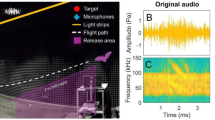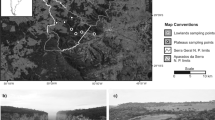Abstract
Bats rely on their hand-wings to execute agile flight maneuvers, to grasp objects, and cradle young. Embedded in the dorsal and ventral membranes of bat wings are microscopic hairs. Past research findings implicate dorsal wing hairs in airflow sensing for flight control, but the function of ventral wing hairs has not been previously investigated. Here, we test the hypothesis that ventral wing hairs carry mechanosensory signals for flight control, prey capture, and handling. To test this hypothesis, we used synchronized high-speed stereo video and audio recordings to quantify flight and echolocation behaviors of big brown bats (Eptesicus fuscus) engaged in an aerial insect capture task. We analyzed prey-capture strategy and performance, along with flight kinematics, before and after depilation of microscopic hairs from the bat’s ventral wing and tail membranes. We found that ventral wing hair depilation significantly impaired the bat’s prey-capture performance. Interestingly, ventral wing hair depilation also produced increases in the bat’s flight speed, an effect previously attributed exclusively to airflow sensing along the dorsal wing surface. These findings demonstrate that microscopic hairs embedded in the ventral wing and tail membranes of insectivorous bats provide mechanosensory feedback for prey handling and flight control.




Similar content being viewed by others
Data availability
Data is available upon request.
References
Adams RA, Snode ER, Shaw JB (2012) Flapping tail membrane in bats produces potentially important thrust during horizontal takeoffs and very slow flight. PLoS ONE 7(2):e32074. https://doi.org/10.1371/journal.pone.0032074
Amichai E, Yovel Y (2021) Echolocating bats rely on an innate speed-of-sound reference. PNAS 118(19):e2024352118. https://doi.org/10.1073/pnas.2024352118
Amichai E, Boerma DB, Page RA, Swartz SM, Ter Hofstede HM (2023) By a whisker: the sensory role of vibrissae in hovering flight in nectarivorous bats. Proc R Soc B 290(1992):20222085. https://doi.org/10.1098/rspb.2022.2085
Anjum F, Turni H, Mulder PGH, Brecht M (2006) Tactile guidance of prey capture in Etruscan shrews. PNAS 103(44):16544–16549. https://doi.org/10.1073/pnas.0605573103
Baker CA, Kohashi T, Lyons-Warren AM, Ma X, Carlson B (2013) Multiplexed temporal coding of electric communication signals in mormyrid fishes. J Exp Biol 216(13):2365–2379. https://doi.org/10.1242/jeb.082289
Boonman A, Rieger I, Amichai E, Greif S, Eitan O, Goldshtein A, Yovel Y (2020) Echolocating bats can adjust sensory acquisition based on internal cues. BMC Bio 18(1):1. https://doi.org/10.1186/s12915-020-00904-2
Boublil BL, Diebold CA, Moss CF (2021) Mechanosensory hairs and hair-like structures in the animal kingdom: specializations and shared functions serve to inspire technology applications. Sensors 21(19):6375. https://doi.org/10.3390/s21196375
Catania KC (2011) The sense of touch in the star-nosed mole: from mechanoreceptors to the brain. Philos Trans R Soc Lond B Biol Sci 366(1581):3016–3025. https://doi.org/10.1098/rstb.2011.0128
Clark KE, Messler KA, Ferkin MH (2020) Sex differences in olfactory social recognition memory in meadow voles, Microtus pennsylvanicus. Ethology 126(10):993–1003. https://doi.org/10.1111/eth.13074
Corcoran AJ, Moss CF (2017) Sensing in a noisy world: lessons from auditory specialists, echolocating bats. J Exp Biol 220(24):4554–4566. https://doi.org/10.1242/jeb.163063
Danilovich S, Yovel Y (2019) Integrating vision and echolocation for navigation and perception in bats. Sci Adv 5(6):eaaw6503. https://doi.org/10.1126/sciadv.aaw6503
Danilovich S, Shalev G, Boonman A, Goldshtein A, Yovel Y (2020) Echolocating bats detect but misperceive a multidimensional incongruent acoustic stimulus. PNAS 117(45):28475–28484. https://doi.org/10.1073/pnas.2005009117
Grant RA, Goss VG (2022) What can whiskers tell us about mammalian evolution, behaviour, and ecology? Mamm Rev 52(1):148–163. https://doi.org/10.1111/mam.12253
Hedrick TL (2008) Software techniques for two- and three-dimensional kinematic measurements of biological and biomimetic systems. Bioinspir Biomim 3(3):034001. https://doi.org/10.1088/1748-3182/3/3/034001
Heiligenberg W (1973) Electrolocation of objects in the electric fish Eigenmannia (Rhamphichthyidae, Gymnotoidei). J Comp Physiol 87(2):137–164. https://doi.org/10.1007/BF01352158
Hope GM, Bhatnagar KP (1979) Electrical response of bat retina to spectral stimulation: comparison of four microchiropteran species. Experientia 35(9):1189–1191. https://doi.org/10.1007/BF01963279
Horowitz SS, Cheney CA, Simmons JA (2004) Interaction of vestibular, echolocation, and visual modalities guiding flight by the big brown bat, Eptesicus fuscus. J Vestib Res 14(1):17–32. https://doi.org/10.3233/VES-2004-14102
Johansson RS, Vallbo AB (1983) Tactile sensory coding in the glabrous skin of the human hand. Trends Neurosci 6:27–32. https://doi.org/10.1016/0166-2236(83)90011-5
Jones TK, Conner WE (2019) The jamming avoidance response in echolocating bats. Commun Integr Biol 12(1):10–13. https://doi.org/10.1080/19420889.2019.1568818
Jones TK, Moss CF (2021) Visual cues enhance obstacle avoidance in echolocating bats. J Exp Biol 224(9):jeb241968. https://doi.org/10.1242/jeb.241968
Knudsen EI, Knudsen PF (1989) Vision calibrates sound localization in developing barn owls. J Neurosci 9(9):3306–3313. https://doi.org/10.1523/JNEUROSCI.09-09-03306.1989
Leem JW, Willis WD, Chung JM (1993) Cutaneous sensory receptors in the rat foot. J Neurophysiol 69(5):1684–1699. https://doi.org/10.1152/jn.1993.69.5.1684
Manfredi LR, Baker AT, Elias DO, Dammann JF, Zielinski MC, Polashock VS, Bensmaia SJ (2012) The effect of surface wave propagation on neural responses to vibration in primate glabrous skin. PLoS ONE 7(2):e31203. https://doi.org/10.1371/journal.pone.0031203
Moss CF, Surlykke A (2010) Probing the natural scene by echolocation in bats. Front Behav Neurosci 4:33. https://doi.org/10.3389/fnbeh.2010.00033
Moss CF, Chiu C, Surlykke A (2011) Adaptive vocal behavior drives perception by echolocation in bats. Curr Opin Neurobiol 21(4):645–652. https://doi.org/10.1016/j.conb.2011.05.028
Muijres FT, Johansson LC, Winter Y, Hedenström A (2014) Leading edge vortices in lesser long-nosed bats occurring at slow but not fast flight speeds. Bioinspir Biomim 9(2):025006. https://doi.org/10.1088/1748-3182/9/2/025006
Sändig S, Schnitzler HU, Denzinger A (2014) Echolocation behaviour of the big brown bat (Eptesicus fuscus) in an obstacle avoidance task of increasing difficulty. J Exp Biol 217(16):2876–2884. https://doi.org/10.1242/jeb.099614
Sterbing SJ, Moss CF (2018) Comparative analysis of the distribution and morphology of tactile hairs on the wing membrane of four bat species. J Mammal 99(1):124–130. https://doi.org/10.1093/jmammal/gyx146
Sterbing-D’Angelo S, Chadha M, Chiu C, Falk B, Xian W, Barcelo J, Zook JM, Moss CF (2011) Bat wing sensors support flight control. PNAS 108(27):11291–11296. https://doi.org/10.1073/pnas.1018740108
Sterbing-D’Angelo SJ, Chadha M, Marshall KL, Moss CF (2017) Functional role of airflow-sensing hairs on the bat wing. J Neurophysiol 117(2):705–712. https://doi.org/10.1152/jn.00261.2016
Stewart WJ, Cardenas GS, McHenry MJ (2013) Zebrafish larvae evade predators by sensing water flow. J Exp Biol 216(3):388–398. https://doi.org/10.1242/jeb.072751
Surlykke A, Moss CF (2000) Echolocation behavior of big brown bats, Eptesicus fuscus, in the field and the laboratory. J Acoust Soc Am 108(5):2419–2429. https://doi.org/10.1121/1.1315295
Wagner H (1993) Sound-localization deficits induced by lesions in the barn owl’s auditory space map. J Neurosci 13(1):371–386. https://doi.org/10.1523/JNEUROSCI.13-01-00371
Webster FA, Griffin DR (1962) The role of the flight membranes in insect capture by bats. Anim Behav 10(3–4):332–340. https://doi.org/10.1016/0003-3472(62)90056-8
Wohlgemuth MJ, Kothari NB, Moss CF (2016) Action enhances acoustic cues for 3-d target localization by echolocating bats. PLoS Biol 14(9):e1002544. https://doi.org/10.1371/journal.pbio.1002544
Acknowledgements
We would like to thank Clarice Diebold for assistance with wing hair depilation, Drs. Kristen Bohn and Jeffrey Bowen for guidance and advice on statistics, and Dr. Dimitri Skandalis for advice on preliminary data analyses. We would also like to thank our team of research assistants: Sarah Huh, Brooke Stanicki, Dean Sheehan, Cory Silver, David Gauthier, Leigh Kinsler, Katherine Armenta, Jessie Gallegos, Kristen Chao, Isaac Lee, Mya Thomas, Adriana Pereira, and Jennifer Cossentino, who were essential during data collection and processing.
Funding
This research was supported by National Science Foundation (NSF), Collaborative Research in Computational Neuroscience (CRCNS): Discovering how touch sensors in the bat’s “hand-wing” enable agile flight control (2011619), Air Force Office of Scientific Research (AFOSR) Center of Excellence (FA9550-14-1-0398NIFTI) and Office of Naval Research (ONR) Multidisciplinary University Research Initiatives (MURI) (N00014-17-1-2736).
Author information
Authors and Affiliations
Contributions
Conceptualization: BLB, GS, SS, CFM; Methodology: BLB, SS, CFM; Formal analysis: BLB, CY; Investigation: BLB, GS; Resources: CFM; Data curation: BLB, CY, CFM; Writing—original draft: BLB; Writing—review and editing: BLB, CY, GS, SS, CFM; Supervision: CFM; Project administration: CFM; Funding acquisition: CFM, SS.
Corresponding author
Ethics declarations
Conflict of interest
The authors declare no conflict of interest.
Additional information
Handling Editor: Andrea Megela Simmons.
Publisher's Note
Springer Nature remains neutral with regard to jurisdictional claims in published maps and institutional affiliations.
Rights and permissions
Springer Nature or its licensor (e.g. a society or other partner) holds exclusive rights to this article under a publishing agreement with the author(s) or other rightsholder(s); author self-archiving of the accepted manuscript version of this article is solely governed by the terms of such publishing agreement and applicable law.
About this article
Cite this article
Boublil, B.L., Yu, C., Shewmaker, G. et al. Ventral wing hairs provide tactile feedback for aerial prey capture in the big brown bat, Eptesicus fuscus. J Comp Physiol A (2023). https://doi.org/10.1007/s00359-023-01682-2
Received:
Revised:
Accepted:
Published:
DOI: https://doi.org/10.1007/s00359-023-01682-2




